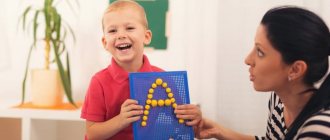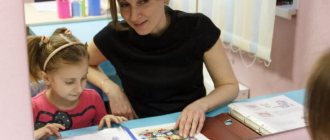“The child has GSD (general speech underdevelopment) level 1" - this is the speech therapy conclusion that the parent of a three-year-old non-speaking child can hear. At this age, some children are seen by a neurologist for various reasons, and not every parent is inclined to consult a speech therapist about lack of speech.
Many people think that speech defects occur only in children with reduced intelligence, deaf or hard of hearing. Alas, this opinion is wrong. Level 1 OHP is also typical for children with initially intact intelligence and normal hearing. If you pay attention to these difficulties in time, start corrective work with a specialist, following all the recommendations, then you can cope with them.
Definition of the concept of ONR level 1
Domestic authors define level 1 OSD as an almost complete absence of speech in a child. Human speech activity consists of several components - this is an active and passive vocabulary, sound pronunciation (the correct pronunciation of individual sounds and sound complexes, as well as the ability to hear these particular sounds), the grammatical structure of speech (the interaction of words with each other), coherent speech (the ability to clearly and clearly express your thoughts without being distracted by details).
In a child with level 1 OHP, all these components are, one way or another, impaired.
Long-term planning of work with children 3-4 years old with general speech underdevelopment of levels 1 and 2
In addition to classes for the development of understanding of speech, active speech, the formation and improvement of the grammatical structure of speech, the development of verbal communication and coherent speech, games, exercises, and classes are conducted for the children of the group to develop auditory attention, phonemic hearing and perception, visual attention and perception, the prosodic aspect of speech , education of general speech skills.
In such classes, children learn to recognize and distinguish non-speech sounds and sound signals consisting of 3-4 words of sounds; a sense of rhythm, auditory-verbal memory, visual memory and attention develops; children develop correct speech diaphragmatic breathing and long speech exhalation; Speech imitation, intonation expressiveness, and rhythm of speech develop.
Throughout the first year of study with children with
OHP 1 and 2 levels, the teacher carries out targeted work on the development of articulatory motor skills, fine motor skills and the psychological basis of speech.
For working with children, complexes have been selected that combine exercises aimed at developing articulatory motor skills, fine movements of fingers, breathing, voice, and the development of the child’s emotional sphere. Complexes are associated with lexical material accessible to children. The game form of teaching the material is most consistent with the psychological capabilities of preschoolers.
Exercises to develop articulatory and fine motor skills are carried out daily so that the motor skills developed by children are consolidated and become stronger. The work takes at least 5 minutes. Articulation exercises are performed in front of a mirror, sitting on a chair, as shown by an adult in stages. The execution of the exercise is also checked step by step.
An important stage of correctional and developmental work in a group is the individual work of the teacher with the child.
Individual work is carried out after subgroup classes and children’s rest. The duration of individual lessons does not exceed 10 minutes. Planning is carried out on the basis of the examination of the child, the recommendations of the State Medical Inspectorate and the psychologist. During the year, two types of individual work planning are used: long-term (for the whole year) and calendar-perspective (for one month). This contributes to more in-depth and high-quality work with each child throughout the school year. Such planning makes it possible to take into account the characteristics of the child’s speech and mental development, consolidate the material covered, and determine the dynamics in development.
It is impossible to talk about the success of correctional and developmental work in a speech therapy group without close contact between the teacher and the parents of preschool children and without their parents’ help. Introductory conversations are held with the parents of the pupils; messages and consultations are offered at the parent corner stands; parents are invited to individual conversations regarding the state of their children’s speech development; are actively involved in the educational and development process.
Subtypes
General underdevelopment of level 1 speech is characterized by a violation of all elements of the speech system.
OHP level 2 – the use of several words in one’s speech, and their pronunciation is not always correct.
OHP level 3 – the child is already able to speak in long phrases, the vocabulary is increasing.
OHP level 4 – at this stage there are minor difficulties, and sometimes mistakes are made. It is important not to stop studying, since individual difficulties can prevent a first-grader or preschooler from coping with reading and writing.
General speech underdevelopment level 2
The main striking difference from level 1 is the constant presence in the child’s speech of a certain number of commonly used words, although not yet pronounced very correctly. At the same time, the beginnings of the formation of a grammatical connection between words are noticeable, although not yet permanent.
What to pay attention to:
- The child always uses the same word, denoting a specific object or action in a distorted form. For example, apple will always sound like “lyabako” in any context.
- The active dictionary is quite poor. The child does not know words denoting the characteristics of an object (shape, its individual parts).
- There is no skill in combining objects into groups (a spoon, plate, pan are utensils). Objects that are similar in some way can be called in one word.
- Sound pronunciation is also far behind. The child pronounces many sounds poorly.
- A characteristic feature of level 2 OHP is the appearance in speech of the rudiments of a grammatical change in spoken words depending on the number. However, the child can only cope with simple words even if the ending is stressed (go - goUt). Moreover, this process is unstable and does not always manifest itself.
- Simple sentences are actively used in speech, but the words in them are not consistent with each other. For example, “papa pitya” - dad came, “guyai gokam” - walked on the hill, etc.
- Prepositions in speech may be completely missed or used incorrectly.
- A coherent story - based on a picture or with the help of an adult's questions - is already obtained, in contrast to the state at level 1 OHP, but it is very limited. Basically, the child uses two-syllable, inconsistent sentences consisting of a subject and a predicate. “Guyai gokam. Videy seg. Ipiy segika." (Walked on a hill, saw snow, made a snowman).
- The syllabic structure of polysyllabic words is disrupted. As a rule, syllables are not only distorted due to incorrect pronunciation, but also rearranged and simply thrown out. (Boots are “bokiti”, people are “tevek”).
Comparative features of speech development disorders
The characteristics of the pathology identified in a child depend on the severity of symptoms:
| Vocabulary | Sound pronunciation | Phonemic awareness/phonemic hearing | Grammatical structure | Syllable structure | Connected speech | Understanding | |
| OHP level 1 | Onomatopoeia, babbling words | Multiple violations | In pristine condition/ grossly damaged | Violated | Violated | Absent | Depends on the situation |
| OHP level 2 | Small (much smaller than normal) | Various and varied distortions, substitutions, lack of sounds | Failure | Not formed | Grossly violated | Phrase of 2-3 words | Develops significantly |
| OHP level 3 | Significantly increases | All types of sound disturbances occur | Insufficiently developed / skills of sound analysis and synthesis are not formed independently | Correct use of simple sentences, specific errors (incorrect agreement, omission and replacement of prepositions, errors in stress) | The syllable structure is less disrupted, but errors remain (syllable shortening, rearrangement, substitution) | Predominance of simple sentences | Already closer to normal |
| OHP level 4 | Practically the norm | There may be distortion of sounds, difficulties in staging [P] | Insufficiently formed | There may be errors in the use of nouns, case endings (genitive and accusative), plurals, and the use of complex prepositions | Some violations remain - abbreviation, rearrangement of sounds, much less often - omission and rearrangement of syllables, addition of syllables | Omission and replacement of conjunctions, inversions (rearrangement of the usual word order in a sentence) | Practically the norm |
As can be seen from the table, each level has its own characteristic features and the first is the most difficult.
Causes
There are several groups of reasons under the influence of which these disorders can occur:
- Pathologies in intrauterine development - toxicosis in the mother in the early stages (when the baby’s nervous system is being formed and formed), various diseases suffered by the mother during the first trimester of pregnancy (viruses and infectious diseases are especially dangerous in the first trimester of pregnancy), Rh conflict.
- Birth pathology - traumatic brain injury, suffocation by the umbilical cord (asphyxia), as a result of which the newborn experiences oxygen starvation, and this, in turn, negatively affects not only the speech centers of the cerebral cortex, but also all other organs and systems.
- Diseases suffered by the child in the first year of life - viral, infectious, various injuries.
- Hereditary factor.
- Negative influence of the environment - the absence or insufficiency of a correctly speaking environment for the child - speech disorders in parents, father and mother with hearing loss (in hearing children), various traumatic situations, frequent and long-term hospitalizations of children.
Mechanisms
Insufficient speech development in a preschooler is a systemic disorder. Patients with this level of development are far behind their peers. If this process is left to chance, the child will not be able to study at school; he will experience not only difficulties in mastering the school curriculum, but also psychological discomfort.
The mechanism of formation of this pathology is associated with one or another lesion of the central nervous system (for example, fetal hypoxia during pregnancy, asphyxia during childbirth, head trauma).
ONR: what is this?
You can suspect a general speech underdevelopment in a child if he said his first words late - by the age of 3 or even later; does not fulfill requests and exhibits low speech activity, does not try to verbally express his desires, and has neurological problems.
In children, not only the process of speech development as a whole is disrupted, but also the sequence and timing of mastering speech skills. In addition, they lag behind the age norm in other criteria, such as mental development.
OHP 1: characteristic of the violation
General underdevelopment of level 1 speech in a young child is characterized by the following signs:
- unformed phrasal speech;
- poor vocabulary;
- reducing sentences to one word;
- misunderstanding of the meanings of words, situational understanding of speech;
- features of articulation: it is incorrect, unclear, the baby pronounces sounds incorrectly or they are completely inaccessible to him;
- rearranging syllables, reducing words to 1 - 2 syllables;
- phonemic analysis of words is not available;
- the use of babble, gestures, facial expressions, amorphous words, and onomatopoeia in communication. Moreover, facial expressions are always applied to the location.
Thus, you don’t even need to be a doctor to understand that the baby has problems.
Level 1 ONR forms
There are 4 clinical forms of general speech underdevelopment of level 1. These include childhood aphasia, alalia, rhinolalia and dysarthria.
Childhood aphasia is an extremely rare disease, occurring in only 1% of children. They do not perceive and recognize speech poorly, do not master phrasal speech, and have difficulty establishing contact with other people. Childhood aphasia is very difficult to recognize in the early stages, so it is usually diagnosed late.
Alalia is underdevelopment of speech or its absence with intact hearing and intelligence. There are sensory and motor alalia. Children with motor alalia can begin to speak by the age of 4, they have poor coordination and fine motor skills, they replace some words with others, cannot express their thoughts, they have no desire to speak, they are touchy. With sensory alalia, children perceive speech incorrectly, repeat words after others, combine two words into one, and they often lack a connection between an object and the word denoting it. Such children can be withdrawn or, conversely, impulsive and very active.
Rhinolalia is manifested by incorrect sound pronunciation and changes in voice timbre. Rhinolalia is associated with impaired velopharyngeal closure.
Dysarthria is difficulty or distorted pronunciation of sounds and words. Associated with impaired innervation and limited mobility of the speech apparatus against the background of damage to the central nervous system.
As children with level 1 ODD say
Children with this diagnosis cannot use verbal means of communication - at all or partially.
Here are examples of level 1 OHP:
- they babble and make sounds: “dada” - “give”, “may” - “meow”;
- they speak only the root part of the word: “ku” - “doll”, “gu” - “toy”;
- denote several objects in one word: “ba” - “banana” and “apple”;
- denote in one word both objects and actions: “bibi” - any transport and “go”, “oko” - open and close a window;
- the same words are pronounced differently each time: “bus” - “abas”, “bass” “pencils” - “adshi”, “udas”;
- they shorten complex words: “the dog is sitting” - “paka di”, “we were walking on a hill” - “goka gi”.
Often such children do not understand the instructions of the speech therapist - they do not have enough vocabulary for this.
Diagnostics
Recognizing and identifying various speech disorders is not only the function of a speech therapist. Primary diagnosis is carried out by the parents or the child’s immediate circle. In the era of the development of modern technologies, every interested adult is able to independently monitor the speech development of their baby, as well as contribute to the activation of these processes. Adults can also notice the first signs of delayed speech development.
Speech development and general physical condition are also monitored by pediatric specialists (including a neurologist and pediatrician). Their conclusions help the speech therapist to create a complete picture - to study the so-called “speech anamnesis” - features of the course of pregnancy, childbirth, and the first year of the child’s life.
General underdevelopment of speech - overcoming.
Step 1. Working with a speech therapist
“My child is already diagnosed with ODD, what should I do?” someone asks. Let's remember that this problem has many causes and consequences, so to get out of it with minimal losses you definitely need the support of a speech therapist. You will have to study a lot, both with specialists and at home. At least once (and often twice) a week it is necessary to work with a speech therapist. The classes will include special games and exercises that will help the child increase his vocabulary, learn to understand and use words correctly, and build coherent and competent sentences.
A program is individually selected and developed for each child. The basis - the development of the grammatical structure of speech and the formation of the ability to correctly construct speech statements - is complemented by all kinds of games that stimulate thinking, memory, and attention. After all, speech does not exist on its own; it is a participant in the process of communication and learning. In addition, speech therapists use all kinds of materials in their work that develop finger dexterity and skill. The areas of the cerebral cortex responsible for the development of speech and the development of fine motor skills are located nearby, stimulating one specialist and having a beneficial effect on the other. There is even such an expression as “intelligence at your fingertips.”
Sound pronunciation will not be left without attention. With general underdevelopment of speech, as a rule, there are difficulties in pronouncing a number of sounds, which is also part of the work of a speech therapist. Such an integrated approach helps to overcome difficulties and has a positive effect on the development of the child as a whole.
Step 2. Your support.
The speech therapist will do everything in his power, but the work of a specialist alone is not enough. The child should become interested in speaking, in communicating something about himself to the world around him and, first of all, to the people closest to him.
A little later we will tell you how underdevelopment of speech can affect the emotional state of a child. For now, let’s just note that correct construction of phrases, selection of the right words, searching for answers to questions asked by adults, pronouncing artificial sounds - all this is difficult work for a child, and he must be sure that you will wait for him to cope with it and help if necessary. You must be extremely patient and attentive when communicating with a child who speaks poorly.
Only if he sees that no matter how ugly and incorrect his speech is, it is important to those around him that he speaks to them, that he is trying to build interaction with them, will the child be able to believe that he is accepted for who he is. And, therefore, he will have less fears and more resources to overcome all difficulties.
Experts to contact
Often, speech disorders are accompanied by neurological pathology, which is expressed by a slow rate of maturation of the nervous system. Therefore, a competent specialist will prescribe special medications that will promote and stimulate its ripening. Accordingly, a neurologist will treat the little patient.
Some children experience psychological difficulties when their words, phrases and sentences are incomprehensible to peers and family. Therefore, in order to cope with them and not lead the child to logophobia (fear of speaking), a child psychologist gets involved. In addition, preschoolers with ODD suffer from higher mental functions that are closely related to speech: memory, attention, thinking.
Speech therapist. The main role in overcoming the above disorders is assigned to this specialist, who will conduct a competent diagnosis, determine the degree of speech development, and outline a lesson plan, goals and objectives. With level 1 OSD, an individual approach to each individual child is necessary, since speech disorders are diverse. The ideal solution would be for the child to attend a speech therapy kindergarten.
Detailed characteristics of OHP 1st degree
A child with this diagnosis is extremely limited in his means of communication. In the active vocabulary, one can identify only a small number of words that are used in everyday life, and the pronunciation of each is unclear. Various onomatopoeias or ordinary sounds can also be added to such phrases.
In most cases, children use their facial expressions and gestures in communication, without separating complexes to describe qualities, actions or objects. Most often, baby babble is regarded as a one-word sentence that is repeated many times.
The child does not differentiate the designations of an object and an action. That is, he can characterize any action with an object, for example, the verb open is replaced by the word door, which is most often pronounced unclearly. The same effect is observed in the opposite way, that is, the object is replaced by an action. The most common example is the replacement of the word “bed” with the verb “pat” (to sleep). Due to a limited vocabulary, one word can have multiple meanings.
The speech of such children is completely devoid of inflections, as a result of which all words are used only in their root form. Each babbling element is accompanied by active gesticulation as additional support for explanation.
In the absence of orienting signs, the child will not be able to distinguish between the plural and singular forms of a noun, as well as the past tense of a verb or masculine and feminine. Most children have a complete lack of understanding of prepositions.
The characteristic of the auditory-speech side with OHP level 1 is phonetic uncertainty. When reproducing sounds, a diffuse character is observed, which is explained by insufficiently developed articulation, as well as a low ability for sound recognition. Most often, defective sounds dominate over correct pronunciation. With level 1 OHP, children cannot distinguish and perceive syllable structure.
Principles of therapy
Correction and treatment of this pathology is carried out by several specialists who use various methods and techniques:
- A speech therapist should begin his work by developing an understanding of the speech of others.
- Gradually accumulate means of communication (increasing vocabulary, expanding the meanings of words, forming correct sound pronunciation).
- Mastering various forms of communication.
Corrective speech therapy work should be combined with concomitant treatment - taking medications, physiotherapy, which will promote and stimulate the maturation of the central nervous system.
Particular attention should be paid to fine motor skills, since training the muscle tone of the fingers helps to activate the brain centers responsible for speech. Finger exercises, games with ice, dough, sandpaper, contrasting hand baths, Kuznetsov’s applicator, etc. have proven their effectiveness.
A favorable prognosis is when the pathology is detected on time and timely treatment and logocorrection are started. If parents are not interested, then the consequences will be sad.
Prevention
Preventive measures flow smoothly from the causes of violations:
- For a woman planning to become a mother, it is important to prepare herself and her body for bearing a baby, take good care of herself, see a doctor, and follow all his recommendations.
- Unfortunately, the moment of childbirth does not always depend on the expectant mother - the main role here is played by medical personnel, or rather by the professionalism and responsibility of each individual employee. The woman, in turn, can have a positive attitude towards the process of childbirth.
- The first year of a baby's life is the most important. The sooner a violation can be detected, the sooner treatment and corrective work can begin.
Recommendations
One of the most important and important recommendations is the joint work of the child, parents and specialists (doctors, speech therapist, psychologist, teacher).
After all, if a preschooler visits a speech therapist, works with him, and at home does not make any efforts to consolidate the skills he has developed, there will not be a proper and necessary effect or he will have to wait a significant amount of time for it. Many parents believe that if a speech therapist or psychologist works with a child, then this is quite enough and they do not need to do anything. This is not so, all new skills and achievements of children must be repeated and improved in familiar situations, they must develop the habit of pronouncing sounds or words correctly.









